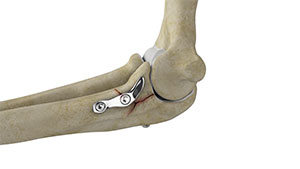
What are Coronoid Fractures?
Coronoid fractures are a break in the coronoid process of the ulna due to trauma or injury. A coronoid fracture of the ulna is a complex intraarticular fracture that is difficult to expose due to complex surrounding anatomical structures. Fractures of the coronoid rarely occur in isolation and often occur in association with elbow dislocations. The coronoid plays a significant role in elbow instability. Large coronoid fractures are often linked with persistent elbow instability even after reduction of the dislocation.
What does ORIF mean?
Open reduction and internal fixation (ORIF) is a surgical technique employed for the treatment of a fracture to restore normal anatomy and improve range of motion and function.
Anatomy
The elbow joint is made up of 3 bones; the humerus (upper arm bone), the radius (forearm bone on the thumb side), and the ulna (forearm bone on the pinkie side). The upper end of the ulna forms a large C-shaped notch known as the trochlear notch that articulates with the trochlea of the humerus to form the elbow joint. The projection that forms the upper border of the trochlear notch is called the olecranon process, and the projection that forms the lower border of the trochlear notch is called the coronoid process.
Causes of Coronoid Fractures
Coronoid fractures may occur in several ways, such as:
- Fall onto an outstretched arm
- Sharp or direct blow on the elbow
- High-impact collision, such as a motor vehicle accident
- Contact sports
Signs and Symptoms of Coronoid Fractures
Signs and symptoms of coronoid fractures may include:
- Elbow pain
- Swelling and bruising
- Deformity
- Numbness or weakness
- Inability to rotate arm
- Tenderness to touch
- Elbow instability
Diagnosis
When you present to the clinic with a fractured coronoid process of the ulna, your doctor will review your symptoms, perform a thorough physical examination, and may order an X-ray or CT scan to identify the type and severity of the fracture as well as assess any injury to the soft tissues.
Procedure for ORIF of the Coronoid Fractures
Open reduction and internal fixation is the procedure employed most often to treat displaced coronoid fractures.
The surgery is performed under sterile conditions in the operating room under general or regional anesthesia.
- After sterilizing the affected area, your surgeon will make an incision around the elbow.
- Your surgeon will locate the fracture by carefully sliding in between or under the muscles of the elbow.
- After carefully visualizing the fracture site, the bone fragments are repositioned (reduced) back to their normal alignment.
- The fragments of bone are then held in place with screws, plates and/or heavy suture.
- After securing the bone, the incisions are closed and a sterile dressing is applied.
Postoperative Care
You may have some pain after procedure and medication will be prescribed to keep you comfortable. After surgery, your arm will be placed in a short splint for support and protection. You will need to keep your arm protected with the aid of a sling to allow for healing. Your doctor will provide instructions on dressings and incision care.
Physical therapy is suggested to prevent arm stiffness, strengthen muscles, and restore range of motion. You will also be advised on a healthy diet and supplements high in vitamin D and calcium to promote bone healing.
Depending on your health condition and the extent of the injury, you may be able to go home the same day with scheduled follow-up appointments for monitoring progress and for stitches or staple removal if necessary. Your doctor will order X-rays to monitor healing throughout your treatment.
Risks and Complications
As with any surgery, some of the potential risks and complications of open reduction and internal fixation of coronoid fractures may include:
- Bleeding
- Swelling
- Infection
- Pain
- Anesthetic complications
- Damage to nerves and blood vessels
- Hardware irritation
- Fracture nonhealing
- Broken hardware
- Repeat surgery
Related Topics
- Open Elbow Surgery
- Distal Biceps Repair
- ORIF of the Humerus Fractures
- Radial Head ORIF and Replacement
- Common Extensor Tendon Origin Repair
- Total Elbow Replacement
- Elbow Arthroscopy
- ORIF of the Coronoid Fractures
- Elbow Ligament Reconstruction
- Elbow Tendon and Ligament Repair
- UCL Reconstruction (Tommy John Surgery)
- Tennis Elbow Surgery
- Ulnar Nerve Release
- Ulnar Nerve Transposition
- ORIF of the Distal Humerus Fractures
- ORIF of the Olecranon Fractures
- Ulnar Collateral Ligament (UCL) Repair with Internal Brace





